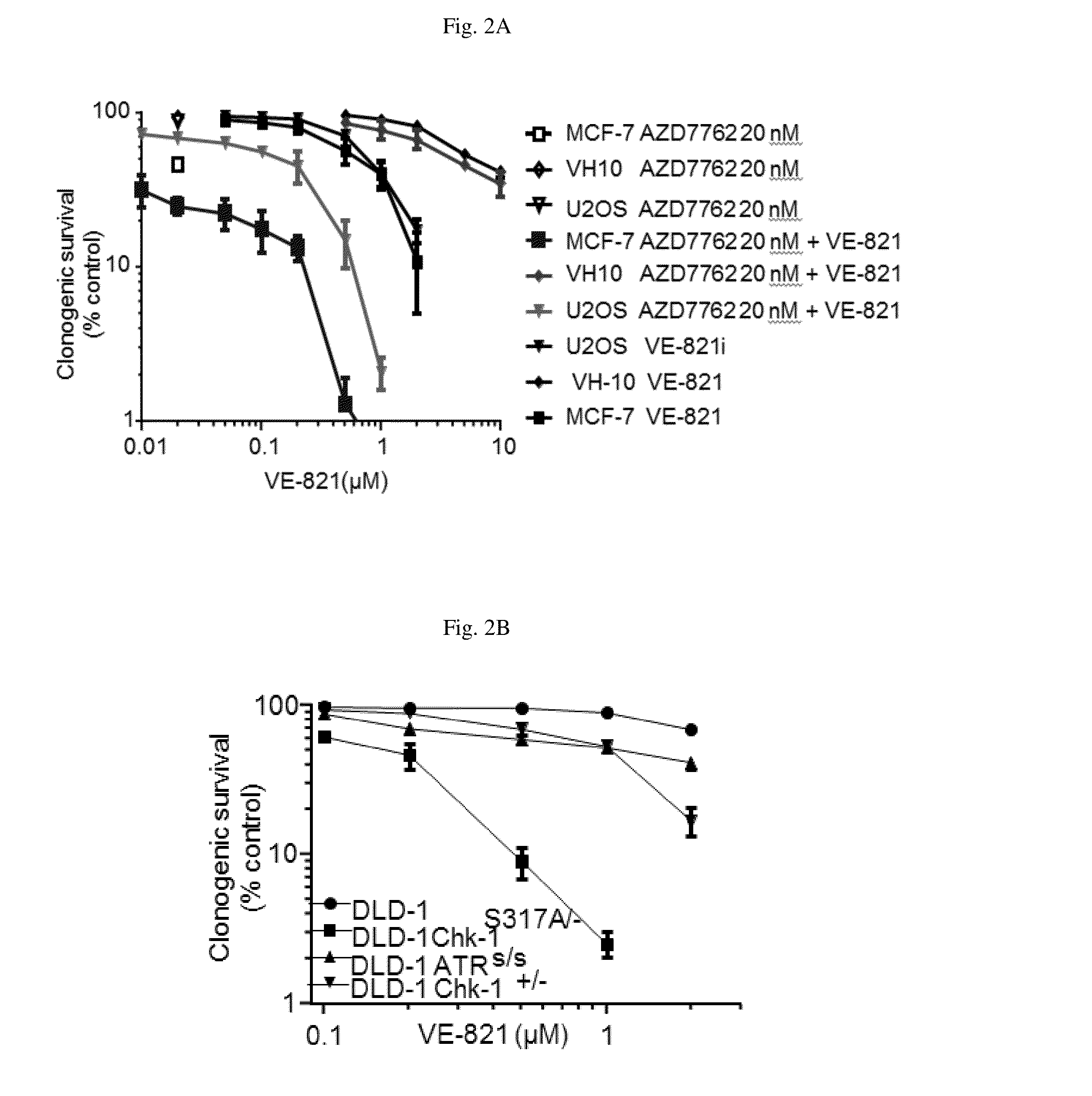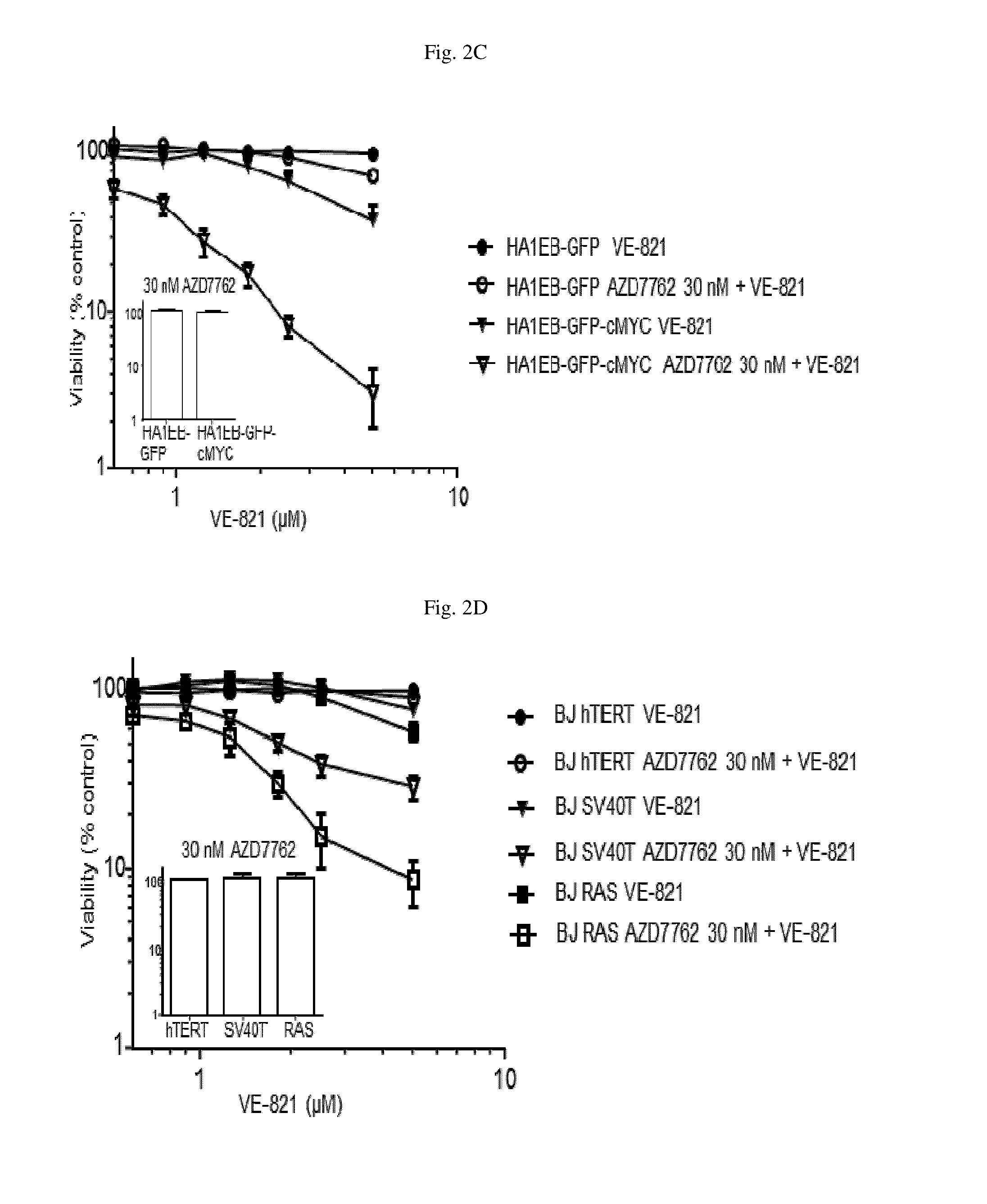Method for treating cancer using a combination of chk1 and atr inhibitors
a technology of atr inhibitor and chk1 is applied in the field of cancer treatment using a combination of atr inhibitor and chk1 to achieve the effect of surprising the synergistic effect of treatmen
- Summary
- Abstract
- Description
- Claims
- Application Information
AI Technical Summary
Benefits of technology
Problems solved by technology
Method used
Image
Examples
example 1
Inhibition of Chk1 and ATR Inhibition Leads to High Levels of DNA Damage
[0315]As shown in FIG. 1, the impact of Chk1 inhibition by AZD7762 on DNA damage levels from treatment of cancer cells with the ATR inhibitor VE-821 was assessed by measuring the accumulation of pan nuclear γH2AX, a widely used marker of DNA damage. γH2AX was detected by western blot. U2OS cancer cells were incubated overnight in 96 well plates and treated for 8 hr. with DMSO AZD7762 (60 nM) and / or VE-821 (10 uM). Cells were stained with anti phosphor (serin 139) histone H2AX antibody as primary and Alexa 555 as secondary. Operetta was used to take images, which were analyzed using Columbus software. Intensity ≧2000 AU was consider as pan nuclear γH2AX cell positive. Data are presented as mean±S.E.M.
[0316]Treatment of U2OS cancer cells with either the ATR inhibitor VE-821 or the Chk1 inhibitor AZD7762 alone had minimal impact on the percentage of cells positive for pan nuclear γH2AX (20% cells staining positive ...
example 2a
Inhibition of Chk1 or Expression of Inactive Mutant Forms of Chk1 Sensitise Cancer Cells to ATR Inhibition
[0317]Referring to FIG. 2A and FIG. 2B, the impact of Chk1 inhibition or expression of inactive Chk1 mutant on cell response to the ATR inhibitor VE-821 was assessed using a clonogenic survival assay in a variety of cancer cells. 500 cells of U2OS, MCF-7, DLD-1, DLD-1 Chk-1S317A / -, DLD-1 Chk-1+ / −, DLD-1 ATRS / S and 1000 cells of VH-10 were plated on 10 cm plate. After 5 hr. of incubation (5% CO2 at 37° C.) vehicle (0.05% DMSO max) various concentration of ATR inhibitor VE-821 were directly added to the media containing plate and incubated for 72 hr. At the end of 72 hr. of incubation, vehicle and drug containing media was replaced with fresh media and further incubated for another 5-8 days before plates were fixed and stained with 4% methylene blue in MeOH and colonies were counted manually. Each data point represents a triplicate data set±SEM.
[0318]Inhibition of Chk1 by AZD7762 ...
example 2b
Expression of the cMYC Oncogene Sensitizes Cells to the Combination of ATR and Chk1 Inhibition
[0319]Referring to FIG. 2C, an isogenic cell line pair differing only in the expression of the oncogene cMYC (HA1EB-GFP parental and cMYC transformed cells, HA1EB-GFP-cMYC) were treated with either VE-821 alone (at concentrations up to 5 μM), AZD7762 alone (30 nM) or the combination of VE-821 and AZD7762 for 72 hours. Cell viability was assessed by resazurin staining. Neither VE-821 nor AZD7762 had a marked effect on viability of the parental cells. Additionally, AZD7762 alone did not impact the viability of the cMYC transformed cells. In contrast, VE-821 reduced the viability of cMYC transformed cells (˜40% viable cells remaining) and the combination markedly reduced cell viability of the cMYC transformed cells (<5% viable cells remaining).
PUM
| Property | Measurement | Unit |
|---|---|---|
| Cell death | aaaaa | aaaaa |
| Therapeutic | aaaaa | aaaaa |
Abstract
Description
Claims
Application Information
 Login to View More
Login to View More - R&D
- Intellectual Property
- Life Sciences
- Materials
- Tech Scout
- Unparalleled Data Quality
- Higher Quality Content
- 60% Fewer Hallucinations
Browse by: Latest US Patents, China's latest patents, Technical Efficacy Thesaurus, Application Domain, Technology Topic, Popular Technical Reports.
© 2025 PatSnap. All rights reserved.Legal|Privacy policy|Modern Slavery Act Transparency Statement|Sitemap|About US| Contact US: help@patsnap.com



